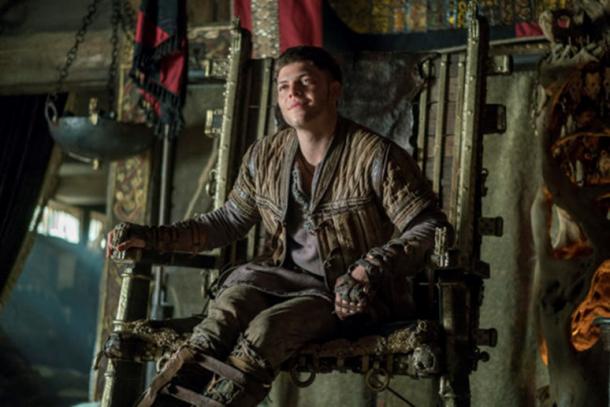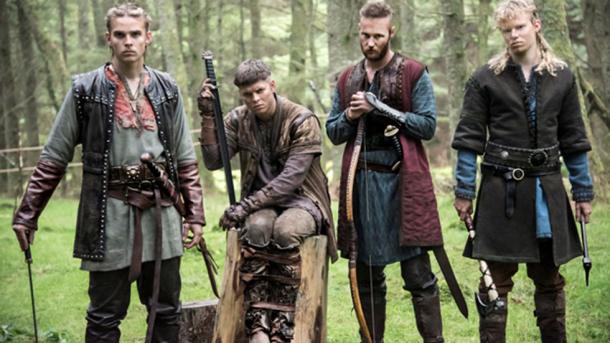Ivar the Boneless: Viking Warrior, Ruler and Raider
One would expect "boneless" to describe a man without a lick of bravery. Or perhaps a man without a shred of compassion in a heart of ice. Yet in the case of the infamous Ivar the Boneless, son of the renowned Ragnar Lodbrok, "boneless" means precisely what it sounds like: a man lacking sturdy bones, but not power.
Ivar Lacked ‘Sturdy Bones’
Possibly the son of Ragnar, best remembered for his horrifying death in a pit filled with venomous snakes, Ivar's existence is as much disputed as his father's. Both men possess names which were highly common in the northern countries in the ninth and tenth centuries, and there are records more formal than the Icelandic sagas which describe the deeds of similarly named men. In the case of Ivar, there is more certainty to his life, though the extent to which his accomplishments were his own rather than men of a similar name remains contested.
Ivar is recorded as likely having a condition called osteogenesis imperfecta, indicating that his body can bend beyond what the average human is capable. Rather than enhancing his performance however, such a condition would damage his body over time, gradually weakening him physically. While such a diagnosis was not quite believable in the ninth century, Ivar's "strange state" was unusual enough that its origins were tacked on to his mythological bio: if he was the son of Ragnar, Ivar's bone deficiency is attributed to Ragnar succumbing to his overwhelming lust for Ivar's mother, Aslaug, before the agreed upon time. In other words, it was a curse.
- The 10th century chronicle of the violent, orgiastic funeral of a Viking chieftain
- New study shows Viking women accompanied men on voyages to colonize far-flung lands
- Ruthless Perception of Vikings Returns as Evidence of the Use of Slaves During the Viking Age Comes into Focus Yet Again

Ivar the Boneless as portrayed in the History Channel Series ‘Vikings’ (History Channel)
The Great Heathen Army
Historically, Ivar—despite his boneless moniker—is highly valued for his role as the leader of the Great Heathen Army in 865 AD, discussed in detail in the Anglo-Saxon Chronicleof the same year. This army—called "heathen" because the ninth century still preceded Christianity in certain northern realms—is credited with a high-scale invasion of the Anglo-Saxons in modern day England. This amalgamation of Danish, Swedish and Norwegian warriors (though these countries were not defined in the ninth century the same way they are today) destroyed their Anglo-Saxon enemies in a short-lived, three-day battle.

History Channel ‘Vikings’ Ivar the Boneless, second left, with his brothers. (History Channel)
According to sources, the Great Heathen Army was headed by Ragnar Lodbrok's three sons, Halfdan Ragnarsson, Ivar the Boneless, and Ubba. As previously stated, due to the lack of certainty in whether their father Ragnar was the same as the snake-sufferer, it is up for debate precisely why the heathen warriors chose to invade England—that is, if there was a reason beyond the "usual" pirating practices begun when the Vikings invaded Lindisfarne in 793 AD. This attack marked the "beginning" of the Viking Age.
If Ivar and his brothers were, in fact, the children of the legendary Ragnar, the significance of this battle increases as the king of Northumbria (one of the Anglo-Saxon kingdoms) was directly responsible for Ragnar's death.
- Exposing the Roots of the Viking Horned Helmet Myth
- Norsemen transformed international culture, manufacturing, tech and trade during Viking Era
- Archaeologists Uncover Evidence of Huge Viking Camp in England
Ivar’s Later Identity
As Ivar the Boneless' parentage is under the umbrella of "legendary", there are other theories as to who this possible historical figure may be. One predominate suggestion is that he is Ímar, a Norse-born ninth century leader of the Viking settlement, Dublin (Dublin was initially settled by the Vikings, just like York in northern England). Ímar is recorded in the Irish Annals, an overarching term for the various historical documents written in regions that correlate to modern day Ireland. As Ímar's life and battle against the king of Ulster coincide chronologically with that of Ivar the Boneless, it has often been contemplated whether these two men were one and the same, and it is merely the fault of time and medieval biases that they're ancestry is recorded differently. Further, Ívar is no longer mentioned in any historical records following the year 870, not even as a deceased individual. Ímar, on the other hand, resurfaces at this time after an absence from the Irish Annals, and his death year is definitively determined as 873. Thus, if Ivar and Ímar were, in fact, the same individual with alternating names, giving Ímar/Ivar Ragnar Lodbrok as a father would have made his role in various battles and settlements far more pertinent mythologically as well as historically.
Imperfect as Ivar might have been by Viking standards, his "bonelessness" seemingly did little to affect his performance as a warrior and leader. He survives in historical record through the test of time, and his deeds are recorded with the same strong language one would expect from a man of his rank. Whether or not Ivar and Ímar are one, the acts attributed to Ivar directly paint him as a durable, determined Viking warrior, whose eventual defeat of his mythological father's killer is his final defining moment.
Top Image: Viking warrior Source: trionis / Adobe Stock
By Riley Winters
Resources
Barrett, James H. 2008. "The Norse in Scotland". In Brink, Stefan. The Viking World. Abingdon: Routledge.
Clarke, D., Blackwell, A. & Goldberg, M., 2013. Early Medieval Scotland: Individuals, Communities and Ideas, Edinburgh: National Museums of Scotland.
Farley, J. & Hunter, F. eds., 2015. Celts Art and Identity, London: The British Museum.
Mac Airt, S. and Mac Niocaill, G. (eds). 1983. The Annals of Ulster (to A.D. 1131). Dublin: Dublin Institute for Advanced Studies.
Roberts, J.L., 1997. Lost Kingdoms: Celtic Scotland and the Middle Ages, Edinburgh: Edinburgh University Press.
Thorpe, B. (ed.) 1861. "The Anglo-Saxon Chronicle." Rerum Britannicarum Medii Ævi Scriptores. Vol. 1. London: Longman, Green, Longman, and Roberts. Accessed April 24, 2017.
Woolf, Alex. 2007. From Pictland to Alba: 789-1070. Edinburgh: Edinburgh University Press.




















Comments
I lean more to the theory that Ivar was actually called ‘the hated’ not ‘the ‘the boneless’. In medieval Latin apparently ‘hated’ is exosus whereas ‘boneless’ is exos and the mistranslation was likely a mistake of a scribe.
The performance of the human body increases when the constraints of bones are ignored.
Ivar was more likely to have Ehlers Danlos Syndrome, my Scandinavian genes gave me this condition, it causes the person to be hypermobile and joints dislocate, hence the "boneless" look of the limbs ect
It gets extremely painful as you age.
Is it possible that Ivar's title "the Boneless" refers not to osteogenesis but rather to the flexibility that training like martial arts develops?